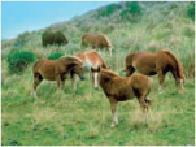Travel Reference
In-Depth Information
The southeast shoreline of Yonaguni, just below Cape Agari, holds several spectacular
rock formations. The first is a little less than 1.25 miles (2 kilometers) southwest of Agarizaki.
It's called Gunkan-iwa (
軍艦岩
; lit. “Battleship Rock”), named for its supposed resemblance
to a great ship. At this same location are the Sanninudai (
サンニヌ 台
) cliffs and observatory.
It's a remarkable vista.
Another kilometer further to the southwest you'll see Tatigami-iwa, also pronounced
Tachigami-iwa (
立神岩
or
タティ ガミイワ
), which translates as “Standing God Rock.”
Tatigami Rock is one of the most photogenic sea buttes you might find anywhere on Earth.
Yonagunijima's most famous sight, however, is not visible to those above water. For this
one, you have to dive. It's known as the “Monument” or the “Underwater Ruins” (
海底遺跡
;
Kaitei-iseki) and it appears to be a man-made undersea fortress or ruin. It's very popular
among divers and one of the main reasons why many tourists come to the island. Although
it's only about 330 feet (100 meters) off the southern coast at Cape Arakawabana (
新川崎
;
Arakawabana-zaki), it's fairly deep, so it's really only accessible to scuba divers, not snorkel-
ers. Even then, rough seas can cause cancellations for many dive excursions. Yonaguni's wa-
ters are no place for beginners. The island is notorious for its dangerous strong currents. Re-
sponsible dive shops only take qualified, certified divers out when conditions are safe. It's
also possible to visit the Monument in a glass-bottomed boat, but since the formation's top is
about 15 feet (5 meters) deep, you won't see all that much, even in these clear waters.


